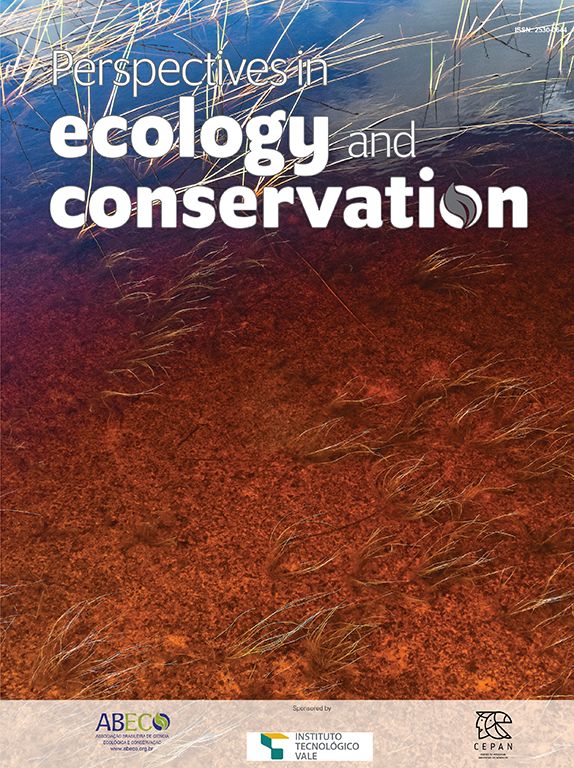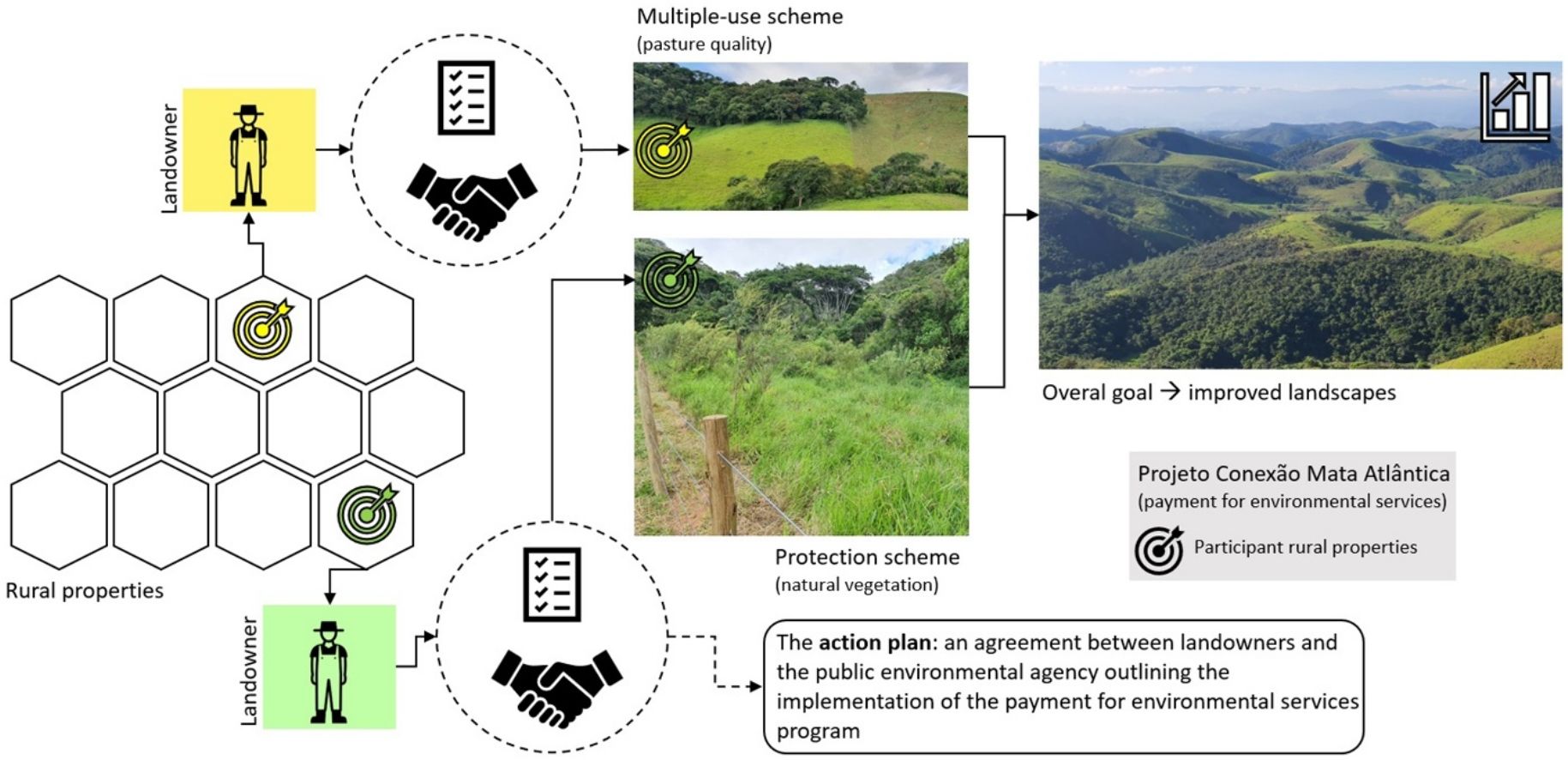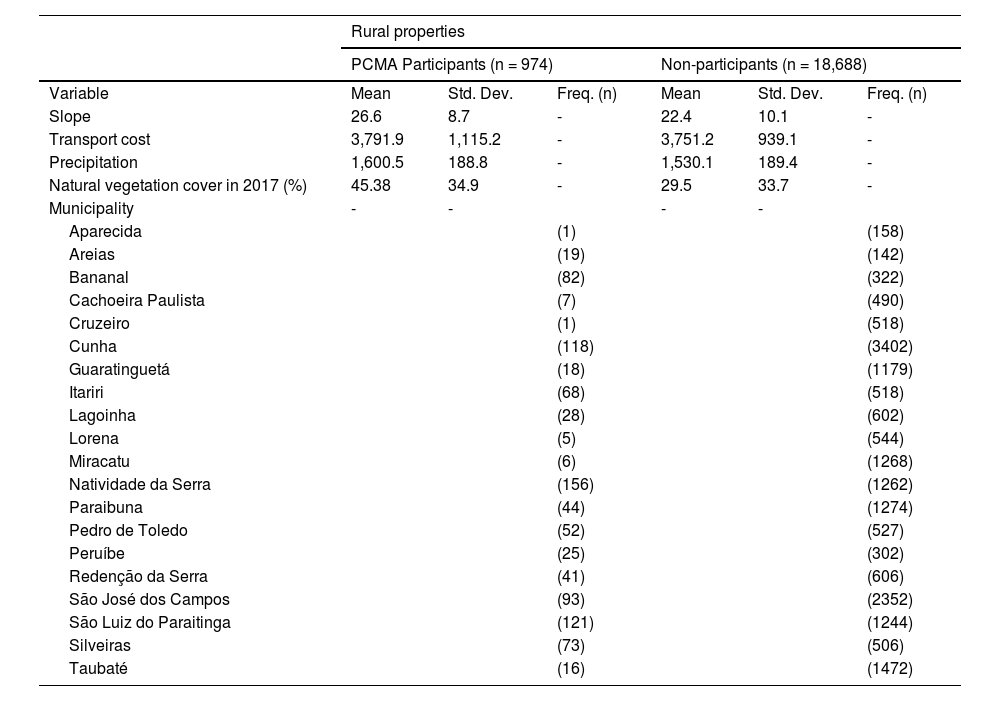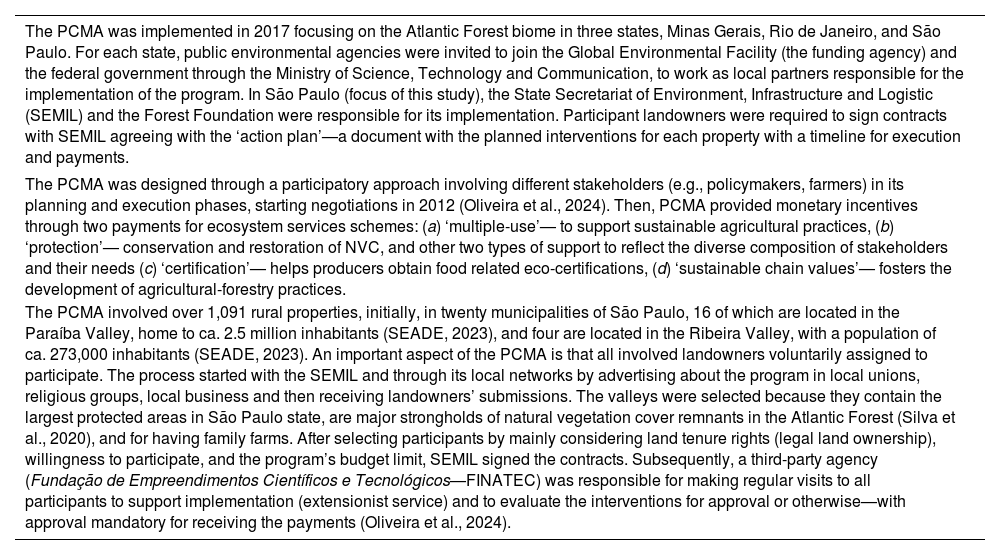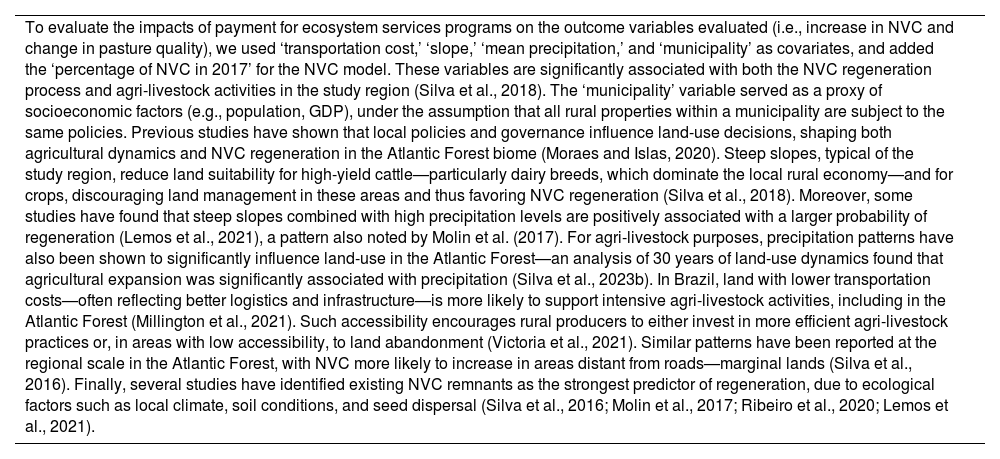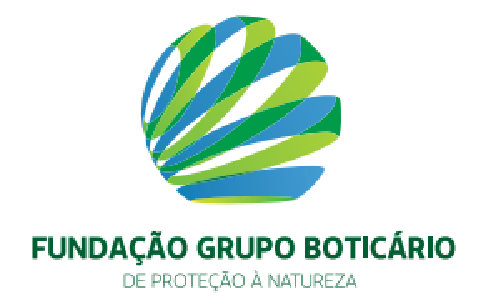In recent decades, Brazil has implemented several payments for ecosystem services (PES) programs, including the Projeto Conexão Mata Atlântica (PCMA), a partnership between the Brazilian federal government, the states of São Paulo, Minas Gerais and Rio de Janeiro and the Global Environmental Facility. The PCMA was co-designed by state organizations with many stakeholders, including landowners. The innovative polycentric approach of the program prompted exploration of different schemes, including one to conserve and restore natural vegetation cover (‘protection scheme’) and another to enhance the multi-functionality of individual properties with focus on pasture quality (‘multiple-use scheme’). Using a propensity score matching approach, we assessed the PCMA’s effects on natural vegetation cover and pasture quality of private rural properties that did and did not participate in this PES program between 2017 and 2022. Properties participating in the ‘protection scheme’ exhibited an average ‘additional’ increase in natural vegetation cover of 1 ha compared to non-participants. Properties participating in the ‘multiple-use scheme’ exhibited 7–10% less pasture quality degradation. These results suggest that the PCMA not have only contributed to maintaining and even increasing ecosystem services (through increases in natural vegetation), but also potentially creating economic benefits by enhancing pasture quality which indirectly improves soil conservation and water quality.
It is well-known that humans are the main source of current environmental transformations around the world (Brondizio et al., 2016). Along with the combustion of fossil fuels, changes in land use/cover (LULC) drive most of the greenhouse gas (GHG) emissions (Curtis et al., 2018), especially in countries like Brazil where deforestation and agricultural expansion are still taking place across large spatial extents (Rajão et al., 2020; Silva et al., 2023a). To reverse environmental degradation, a series of tools and mechanisms have been created under different environmental governance frameworks (Steiner et al., 2003), including the development of sustainability standards for supply chains (e.g., eco-certifications; Lambin and Thorlakson, 2018), and the development and implementation of programs of Payment for Ecosystem Services (PES; Liu and Yang, 2013). PES are known as a key mechanism that uses incentives (e.g., cash, in-kind transactions, rural assistance) to foster changes in resource-use practices or to conserve and restore natural areas (Grima et al., 2016). PES programs implemented within private rural properties are considered effective tools for increasing the efficiency of conservation investments worldwide (Ferraro and Simpson, 2002). Nevertheless, while ecosystem restoration has become a priority and governments worldwide are establishing targets for restoration over the coming decades (Verdone and Seidl, 2017), restoration actions are costly, which may jeopardize their long-term implementation and maintenance (Brancalion et al., 2019; Lemos et al., 2021). Therefore, analyses of the effectiveness of PES programs are crucial for evaluating whether such policy interventions support conservation and restoration targets.
Over the last twenty years, Brazil has implemented more than 80 PES programs throughout the country (Mota et al., 2023; Mamedes et al., 2023). For instance, in 2012 the Global Environmental Facility, along with local environmental agencies in the Atlantic Forest biome, initiated a discussion to implement a conservation program named “Projeto Conexão Mata Atlântica” (PCMA), which included PES within its strategy. Implemented in 2017 with a total budget of R$33 million/≈US$6.5 million, the PCMA initially involved 1,091 private rural properties in the Paraíba and Ribeira valleys, São Paulo state (Oliveira et al., 2024). Through the use of economic incentives and technical support for conservation/restoration, the PCMA promoted a several schemes that foster natural vegetation cover (NVC) conservation and restoration (‘protection’ scheme), and to improve management practices in agricultural systems, as recovering pasture quality (‘multiple-use’ scheme) (Oliveira et al., 2024).
The implementation of these schemes enhanced the expectation that the PES program would generate ‘additionality’—i.e., benefits resulting from an intervention that would not occur in its absence (Tacconi, 2012). In other words, if non-participant rural properties experience NVC gains through land abandonment or restoration initiatives, NVC gains in properties participating in the PCMA would need to occur at a higher rate for the program to be generating ‘additionality’. This additional effect is an important component of public policy evaluation (and key for inferring causality; Bayles et al., 2016) but constitutes a challenge in real world situations, as it requires the use of data from observations rather than from formal controlled experiments (Schaefer and Figueiredo, 2023). Furthermore, two recent systematic reviews on PES in Brazil have highlighted a significant knowledge gap regarding their actual impacts on ecosystems (Mota et al., 2023; Mamedes et al., 2023). To start addressing this knowledge gap, this study assessed the following questions: (i) Has the restoration of natural vegetation cover in private properties participating in the PCMA been significantly larger than the baseline natural regeneration observed due to land abandonment in non-participating properties? (ii) Has pastureland in PCMA-participating properties exhibited significantly greater improvement in quality compared to the improvement observed in non-participating properties? (iii) Did payments by the PCMA for the restoration of natural vegetation cover cost less compared to prices observed in other restoration practices?
MethodsDataThis study took advantage of remotely-derived land use/cover and pasture quality data from 2017 to 2022 at high spatial resolution, rural property data from then Rural Environmental Cadastre—CAR, and on the participation in the PCMA in the Paraíba (Fig. 1a) and Ribeira (Fig. 1b) Valleys of São Paulo state (Fig. 1; Box A—Projeto Conexão Mata Atlântica) Brazil, and a set of socioeconomic and biophysical datasets (Supplementary Information—SI 1: Full description of datasets). This dataset was used to develop a procedure for assessing some of the environmental effects of the implementation of the PCMA. Thus, our study evaluated the performance of a public program for PES using observational data. Based on the propensity score matching approach (Zhou et al., 2022), the developed procedure allowed evaluating the significance of the additionality generated by the schemes under the PCMA, while removing the confounding effects of covariates.
Geographical distribution of rural properties participating in the “Projeto Conexão Mata Atlântica” (PCMA) in the Brazilian state of São Paulo. (a) Distribution of 823 participants in the Paraíba Valley region, across sixteen municipalities. (b) Distribution of 151 participants in the Ribeira Valley region, across four municipalities.
Projeto Conexão Mata Atlântica (PCMA) and the payment for ecosystem services.
| The PCMA was implemented in 2017 focusing on the Atlantic Forest biome in three states, Minas Gerais, Rio de Janeiro, and São Paulo. For each state, public environmental agencies were invited to join the Global Environmental Facility (the funding agency) and the federal government through the Ministry of Science, Technology and Communication, to work as local partners responsible for the implementation of the program. In São Paulo (focus of this study), the State Secretariat of Environment, Infrastructure and Logistic (SEMIL) and the Forest Foundation were responsible for its implementation. Participant landowners were required to sign contracts with SEMIL agreeing with the ‘action plan’—a document with the planned interventions for each property with a timeline for execution and payments. |
|---|
| The PCMA was designed through a participatory approach involving different stakeholders (e.g., policymakers, farmers) in its planning and execution phases, starting negotiations in 2012 (Oliveira et al., 2024). Then, PCMA provided monetary incentives through two payments for ecosystem services schemes: (a) ‘multiple-use’— to support sustainable agricultural practices, (b) ‘protection’— conservation and restoration of NVC, and other two types of support to reflect the diverse composition of stakeholders and their needs (c) ‘certification’— helps producers obtain food related eco-certifications, (d) ‘sustainable chain values’— fosters the development of agricultural-forestry practices. |
| The PCMA involved over 1,091 rural properties, initially, in twenty municipalities of São Paulo, 16 of which are located in the Paraíba Valley, home to ca. 2.5 million inhabitants (SEADE, 2023), and four are located in the Ribeira Valley, with a population of ca. 273,000 inhabitants (SEADE, 2023). An important aspect of the PCMA is that all involved landowners voluntarily assigned to participate. The process started with the SEMIL and through its local networks by advertising about the program in local unions, religious groups, local business and then receiving landowners’ submissions. The valleys were selected because they contain the largest protected areas in São Paulo state, are major strongholds of natural vegetation cover remnants in the Atlantic Forest (Silva et al., 2020), and for having family farms. After selecting participants by mainly considering land tenure rights (legal land ownership), willingness to participate, and the program’s budget limit, SEMIL signed the contracts. Subsequently, a third-party agency (Fundação de Empreendimentos Científicos e Tecnológicos—FINATEC) was responsible for making regular visits to all participants to support implementation (extensionist service) and to evaluate the interventions for approval or otherwise—with approval mandatory for receiving the payments (Oliveira et al., 2024). |
The dataset used included a total of 934 rural properties (ranging in size from 0.2 to 1,400 ha) that participated in the PCMA program (890 of which executed at least 10% of their action plan), and 18,688 non-participating properties (ranging in size from 0.2 to 2,700 ha—i.e., all other rural properties found in the study regions). In the study region, 91% of rural properties and 88% of PCMA participants own land ≤4 fiscal modules (averaging 20 ha each). The fiscal module, established by Law 6746/1979, defines the minimum economically viable rural property size and is used to classify small properties (≤4) under the Agrarian Reform Law (Law 8629/1993).
Statistical analysisTo evaluate the effects of the PES schemes under the PCMA on the recovery of natural vegetation cover (NVC) and on changes in pasture quality between 2017 and 2022, we utilized a quasi-experimental design by adopting the propensity score matching approach (Zhou et al., 2022). This approach has been successfully applied in previous studies to evaluate the causal effects of specific policy interventions (Bayles et al., 2016) by comparing outcomes of samples under an intervention (i.e., treatment) against counterfactual no-intervention samples. Our analysis comprised the period starting in 2017, as it constitutes the first year of the PCMA implementation, and concluding in 2022, the year of the completion of the payments following the action plans agreed at the beginning of the Conexão (Oliveira et al., 2024).
The dependent (outcome) variables for the matching approach were NVC and pasture quality, while a set of biophysical and socioeconomic covariates were used to control for the effects between participants and non-participants. The treatment variable used to assess the impact of PES ‘protection’ scheme on NVC was participation by rural properties, (model 1; with participants assigned a value of 1, and non-participants a value of 0; SI 2: Figure S1). For the two outcome variables representing changes in pasture quality (to evaluate trends in low quality—model 2, and high quality—model 3 between 2017 and 2012), the treatment variable was represented by the PES ‘multiple-use’ scheme. Selected covariates for propensity score matching were those demonstrated to have an association with the outcome variables in previous studies of land-use decisions in the Atlantic Forest, and include land abandonment, cattle ranching activities, conservation practices and ecosystems restoration (see Box B—Covariate selection for full details). For additional information on model settings, see the Supplementary information (SI 3: Natural vegetation cover model; SI 4: Pasture quality model).
Covariate selection.
| To evaluate the impacts of payment for ecosystem services programs on the outcome variables evaluated (i.e., increase in NVC and change in pasture quality), we used ‘transportation cost,’ ‘slope,’ ‘mean precipitation,’ and ‘municipality’ as covariates, and added the ‘percentage of NVC in 2017’ for the NVC model. These variables are significantly associated with both the NVC regeneration process and agri-livestock activities in the study region (Silva et al., 2018). The ‘municipality’ variable served as a proxy of socioeconomic factors (e.g., population, GDP), under the assumption that all rural properties within a municipality are subject to the same policies. Previous studies have shown that local policies and governance influence land-use decisions, shaping both agricultural dynamics and NVC regeneration in the Atlantic Forest biome (Moraes and Islas, 2020). Steep slopes, typical of the study region, reduce land suitability for high-yield cattle—particularly dairy breeds, which dominate the local rural economy—and for crops, discouraging land management in these areas and thus favoring NVC regeneration (Silva et al., 2018). Moreover, some studies have found that steep slopes combined with high precipitation levels are positively associated with a larger probability of regeneration (Lemos et al., 2021), a pattern also noted by Molin et al. (2017). For agri-livestock purposes, precipitation patterns have also been shown to significantly influence land-use in the Atlantic Forest—an analysis of 30 years of land-use dynamics found that agricultural expansion was significantly associated with precipitation (Silva et al., 2023b). In Brazil, land with lower transportation costs—often reflecting better logistics and infrastructure—is more likely to support intensive agri-livestock activities, including in the Atlantic Forest (Millington et al., 2021). Such accessibility encourages rural producers to either invest in more efficient agri-livestock practices or, in areas with low accessibility, to land abandonment (Victoria et al., 2021). Similar patterns have been reported at the regional scale in the Atlantic Forest, with NVC more likely to increase in areas distant from roads—marginal lands (Silva et al., 2016). Finally, several studies have identified existing NVC remnants as the strongest predictor of regeneration, due to ecological factors such as local climate, soil conditions, and seed dispersal (Silva et al., 2016; Molin et al., 2017; Ribeiro et al., 2020; Lemos et al., 2021). |
The matching approach estimated the Average Treatment effect on the Treated (ATT) to assess the effects of an intervention (Zhou et al., 2022). Here, the ATT was defined as the difference between the average outcome (e.g., NVC increase) in properties participating in the PCMA (treatment group) and the average outcome in non-participants (control group). For each property in the treatment group, the matching method finds a property in the control group that is similar in terms of the observable attributes (called confounding factors; Zhou et al., 2022). After controlling for confounding factors (i.e., the covariates), the difference in the values of the dependent variable (e.g., NVC increase) between treatment and control groups represents the effect of the program—i.e., the ATT.
To perform the matching approach, we first ran the ‘Genetic Matching’ (GenMatch) algorithm. Because matching without replacement may increase bias, we decided to use replacement (Sekhon, 2011). One-to-one matching entails pairing each treated unit with a corresponding control unit, a strategy that safeguards precision by mitigating the risk of leaving excessive control units unmatched and subsequently excluded from the matched sample (Rosenbaum, 2020). The GenMatch algorithm iteratively checks the propensity scores and measures the distance between treatment and control groups. This algorithm is a form of nearest neighbor matching where distances are computed as the generalized Mahalanobis distance, with a scaling factor for each covariate that represents the importance of that covariate to the distance—finding a good matching solution (Diamond and Sekhon, 2013). With the balance for covariates found through the GenMatch, we ran the ‘match’ algorithm for causal effect estimates (two-sided t-test) with bias adjusted and using the Abadie-Imbens estimator to obtain standard errors (Abadie and Imbens, 2006). After matching, we used four metrics to assess the quality of the covariate balance between the control and treatment groups for each model: (i) mean empirical quantile-quantile (eQQ), (ii) the difference in mean, (iii) the standardized mean difference, and (iv) the empirical distributions of each variable in both groups.
Hence, the propensity score matching approach was employed specifically to control for observed covariates and create a balanced set of control properties, allowing us to isolate and evaluate the effects of program participation. In such studies, covariates are included solely to minimize confounding effects, without the intention of assessing their impact on the response variable (Austin, 2011). To ensure confidence in the results from the models, this study used the Rosenbaum Bounds for Hodges-Lehmann Point Estimate and evaluated the Standardized Mean Difference of each model (SI 5: Sensitivity Analysis). Given that the PCMA data includes the monetary values provided to each participant, we examined the costs for restoration in the ‘protection’ scheme (total protection budget estimated at R$8.3 million/≈US$1.5 million; Oliveira et al., 2024) by comparing them with restoration market price estimates from the Brazilian Ministry of Environment (MMA, 2017; Brancalion et al., 2019), and from a local restoration business of the Paraíba Valley with values relative to 2024 (SI 6: Cost comparison analysis for restoration).
ResultsImpacts of the PCMA on natural vegetation coverThe total area occupied by all rural properties is around 936,000 ha, while between 2017 and 2022, NVC exhibited an increase of 1.7%, equivalent to a net gain of 8,283 ha (from 477,000 ha in 2017 to 485,000 ha in 2022). This result constitutes a remarkable indicator of the regeneration/recovery of natural ecosystems at local scales in the Atlantic Forest biome (Fig. 2). Table 1 presents a summary of the covariate statistics. Over this period, the NVC in the properties participating in the PCMA program had a net increase of 2.17% (633 ha), which although a statistically significant higher increase than non-participating properties (one-tailed Welch’s t-test, p < 0.05), this difference is not statically significant after accessing by a matching propensity score model. However, focusing on the specific PES ‘protection’ scheme (model 1), we found a significant result (Table 2, model 1), which indicates that the ‘protection’ scheme is in fact improving the trend of NVC increase in the region by providing significant additional gains in PCMA participants—in this case an additional increase of 1 ha. Furthermore, from a set of 310 rural properties participating in the PCMA ‘protection’ scheme, 177 exhibited a mean NVC increase of 2.67 ha, which is 1.7 times higher than that of non-participating properties (mean of 1.57 ha across 7,420 properties). In summary, the results from model 1 allow inferring that, after controlling for covariates (SI 7: Figure S2-model 1, and SI 8: Table S1), the PCMA scheme focusing on NVC provided a significant increase of NVC in participating properties compared to non-participating properties, with a mean additional gain of 1 ha.
Summary statistics of covariates used in the propensity score matching approach—slope (%), precipitation (mm yr−1), transport cost (relative index), and natural vegetation cover in 2017 (%). For the categorical variable ‘municipality’, absolute frequencies are provided. Statistics are provided for both groups, the rural properties participating and not participating in the Projeto Conexão Mata Atlântica (PCMA).
| Rural properties | ||||||
|---|---|---|---|---|---|---|
| PCMA Participants (n = 974) | Non-participants (n = 18,688) | |||||
| Variable | Mean | Std. Dev. | Freq. (n) | Mean | Std. Dev. | Freq. (n) |
| Slope | 26.6 | 8.7 | - | 22.4 | 10.1 | - |
| Transport cost | 3,791.9 | 1,115.2 | - | 3,751.2 | 939.1 | - |
| Precipitation | 1,600.5 | 188.8 | - | 1,530.1 | 189.4 | - |
| Natural vegetation cover in 2017 (%) | 45.38 | 34.9 | - | 29.5 | 33.7 | - |
| Municipality | - | - | - | - | ||
| Aparecida | (1) | (158) | ||||
| Areias | (19) | (142) | ||||
| Bananal | (82) | (322) | ||||
| Cachoeira Paulista | (7) | (490) | ||||
| Cruzeiro | (1) | (518) | ||||
| Cunha | (118) | (3402) | ||||
| Guaratinguetá | (18) | (1179) | ||||
| Itariri | (68) | (518) | ||||
| Lagoinha | (28) | (602) | ||||
| Lorena | (5) | (544) | ||||
| Miracatu | (6) | (1268) | ||||
| Natividade da Serra | (156) | (1262) | ||||
| Paraibuna | (44) | (1274) | ||||
| Pedro de Toledo | (52) | (527) | ||||
| Peruíbe | (25) | (302) | ||||
| Redenção da Serra | (41) | (606) | ||||
| São José dos Campos | (93) | (2352) | ||||
| São Luiz do Paraitinga | (121) | (1244) | ||||
| Silveiras | (73) | (506) | ||||
| Taubaté | (16) | (1472) | ||||
Impacts of the payment for ecosystem service schemes under the Projeto Conexão Mata Atlântica on natural vegetation cover (NVC) and pasture quality identified using the propensity score matching approach. Dependent variables are NVC increase (model 1), low and medium pasture quality change (model 2) and high pasture quality change (model 3), all for the period 2017-2022. All models exhibited values equal or larger than the threshold of 1.5 in sensitivity, and SMD < 0.25 indicating that they are robust to hidden biases. The impact estimated using matching represents the average treatment effect on the treated (ATT).
| Parameters | Model 1 | Model 2 | Model 3 |
|---|---|---|---|
| Impact estimated using matching | 1.00* (0.39) | −10.66* (4.00) | 7.22** (2.28) |
| Γ Sensitivity | 2.1 | 1.8 | 1.5 |
| Standardized Mean Difference (SMD) | <0.1 | <0.1 | <0.1 |
| Number of treatments | 177 | 79 | 245 |
| Number of matched | 177 | 79 | 245 |
| Number of observations | 7,909 | 5,908 | 13,012 |
*p-value < 0.05; **p-value < 0.01. Abadie-Imbens standard errors in parentheses.
It is worth noting that NVC losses were also observed in both PCMA participants and non-participants. For the former, this totaled 290 ha of losses in 151 properties, compared to 4,014 ha within 2,851 properties for the latter.
Impacts of the PCMA on pasture qualityOver the study period a general trend of pasture quality decrease was observed for the entire study area. Considering the total number of rural properties with pasturelands in 2022 (14,648), the average quality decreased from 1.32 (considering the quality scale of 1-low, 2-medium, and 3-high) in 2017 to 1.18 in 2022 (a decrease of 0.14). Over the same period, we observed a general trend in pasture area decrease of 12,375 ha (1.3% of the study area). For the group of rural properties participating in the PCMA ‘multiple-use’ scheme, the average decrease in pasture quality was slightly lower, at 0.12. However, when our model focused on pasture quality classes 1-low and 2-medium, model 2 (considering only the 5,908 properties with increased trends in these classes), non-participating rural properties exhibited a 31.33% increase in these classes combined. For the properties participating in the ‘multiple-use’ scheme (79 properties), the increase was 25.65%. After controlling for covariates (SI 7: Figure S2-model 2, and SI 9: Table S2), our model found a slightly higher and statistically significant difference of −10.66% (Table 2-model 2). This result indicates that the ‘multiple-use’ scheme effect on participating properties prevented an increase of 1-low and 2-medium pasture quality classes of around 10.66%. In SI 10: Figure S3 we present the spatial distribution of these changes.
Regarding exclusively the pasture quality class 3-high, between 2017 and 2022 the study area lost 52,600 ha (9.5%). In model 3, we aimed to evaluate the changes in this pasture quality class, after establishing an adequate covariate balance (SI 7: Figure S2-model 3, and SI 11: Table S3). Results from this model show a significant (Table 2-model 3) difference between rural properties participating in the ‘multiple-use’ scheme (245) against non-participating properties (12,767) of 7.22%. While the general trend for properties participating in the ‘multiple-use’ scheme was a decrease of 4.43%, non-participating properties exhibited a decrease of 11.89%. SI 12: Figure S4 displays the spatial distribution of the change in pasture quality 3-high. Results from models 2 and 3 allow us to infer that the ‘multiple-use’ scheme provided the capacity of properties participating in PCMA to significantly mitigate the degradation of pasture quality over the study period.
Cost comparison analysis for restorationThe PCMA program in São Paulo state, invested a total of R$32.3 million between 2017 and 2022, corresponding to an average of R$31,500 per participating rural property. Considering just the rural properties participating in the ‘protection’ scheme, the total value reached R$8.3 million (R$27,000 on average per property—310 properties), and with an average of R$786 per ha—this estimate refers to the total value given the total area (i.e., 10,628 ha) that landowners participating in the ‘protection’ scheme committed to conserve or restore according to their ‘action plan’. However, considering just the 177 properties with NVC increase of the ‘protection’ scheme, the total R$6 million paid respective to these properties reached a cost per ha of R$988 (considering the total 6,068 ha that landowners committed to in the ‘action plan’). Nonetheless, we observed an increase of 476 ha of new NVC for this specific group. This represents an average of R$12,600 per ha of new areas of NVC. Bearing in mind the cost per ha for restoration in the Atlantic Forest by active regeneration (i.e., by planting new areas with natural vegetation), the cost per ha would range between R$7,700 and R$21,200 (an average of R$14,400) from estimates of 2017 by the MMA (2017). These results are also aligned with restoration costs estimated around 2018 by Brancalion et al. (2019), where the active restoration reached an average of approximately R$10,000 per ha for the Atlantic Forest. However, from the local Paraíba Valley restoration business, the average cost for active restation in 2024 was R$68,900 per ha (for this estimate cost the local business includes fencing, which is the same procedure adopted by landowners participating in the PCMA). Here we note that for the properties participating in the ‘protection’ scheme were conducted mainly through assisted restoration (i.e., natural regeneration with some, but limited, tree planting), which is cheaper compared to active restoration (Brancalion et al., 2019). In this case, taking into consideration the cost from the local Paraíba Valley business for assisted restoration at R$23,000 per ha, the results achieved by the PCMA at R$12,600 indicate that better returns for the monetary investments are more likely to be achieved under policy frameworks such as PES.
DiscussionBrazil has a large deficit of natural vegetation cover – estimated at ≈27 Mha – that needs to be fulfilled to achieve legal compliance with the national Forest Code (Silva et al., 2023a). Nonetheless, to ensure rural landowners comply with this code it is necessary to go beyond command-and-control strategies (Uehara and Casazza, 2011) and incorporate land-use planning (Silva et al., 2023c) together with monetary incentives (Lemos et al., 2023). Our analysis found that the PCMA program has the potential to accelerate NVC gains at affordable costs considering current market prices for restoration. Despite the considerable range between major studies on restoration costs in the Atlantic Forest (MMA, 2017; Brancalion et al., 2019, and local Paraíba Valley estimates), our results suggest that the PCMA program achieved more affordable restoration outcomes. Previous economic modeling efforts in the Atlantic Forest have demonstrated the potential of PES programs to promote NVC restoration, while reducing landowners’ restoration costs (Lemos et al., 2023). Hence, our cost comparison analysis provides useful insights into the costs for restoration under a PES policy framework, which was expected to lower restoration costs by applying ‘reverse auctions’ (SI 6) to attract landowners to participate in the PCMA (Oliveira et al., 2024), while engaging them into a participatory process (Pereira, 2024).
The PCMA program shows potential to harness the ongoing natural regeneration process by adding 1 ha to each hectare that increases without any incentive (i.e., this is the additionality promoted by the PES ‘protection’ scheme; Table 1-model 1). This result demonstrates the capacity of such initiatives to enhance environmental restoration, thus strengthening the argument that policy interventions may achieve successful outcomes when designed and implemented through participatory processes (collaborative approaches involving policymakers, technicians, rural extension professionals, and landowners; Henderson et al., 2020).
Although we found a non-significant NVC increase based on a robust propensity score matching model when considering all PCMA participants, our data still pointed to a significant higher increase by a one-tailed Welch’s t-test. This is an interesting result since the PES ‘multiple-use’ scheme, and the two other types of support by the PCMA program: ‘certification’, and ‘sustainable value chain’ (Box A), involved the implementation of agroforestry systems, together with land-use relocation strategies (e.g., fostering abandonment of low productivity areas), an approach designed for indirectly sustaining increases in NVC (Oliveira et al., 2024). On this regard, our results indicate that ecosystem restoration may also be attained through economic incentives aimed at fostering sustainable land-agricultural practices—i.e., “ecosystem services provision within productive landscapes” (Oliveira et al., 2024). Although not the focus of this study, NVC losses were also observed during the period of analysis, in both PCMA participant and non-participant properties. Such losses may be due in part to fire, which not only represents a major threat to the NVC within the Paraíba and Ribeira valleys in São Paulo state (Silva et al., 2018; Ferreira et al., 2023), but it is also a growing threat at the biome level (SOS Mata Atlântica, 2025). Thus, future studies should evaluate the impacts of fire on restoration outcomes.
Pasture degradation and its recovery is a major challenge in Brazil, affecting not only livestock production (Bolfe et al., 2024) but compromising soil and water quality (Lemos et al., 2023). Important linkages have also been noted among degraded pasture, carbon stocks and NVC. For instance, the national policy “ABC Plan-Low carbon emission” targets pasture restoration as a means to increase carbon sequestration (Gianetti and Ferreira Filho, 2021), while some studies have already demonstrated that recovering pasture quality may create a ‘land-sparing’ effect, alleviating deforestation trends (Stabile et al., 2023). Although there was an overall general trend of pasture quality improvements over the last decades in Brazil (Santos et al., 2022), our study found a declining trend since 2017. However, for rural properties participating in the PCMA ‘multiple-use’ scheme, we observed a significantly lower decreasing trend. Our propensity score matching models estimate that participant properties had, on average, a 7% higher increase in high-quality pastures and a 10% lower increase in low- and medium-quality pastures compared to similar non-participant properties. These differences represent the additionality effects attributed to the program. These findings suggest that the concerted efforts within participating properties contributed to the resilience of producers, contrasting with the stronger declining trend observed throughout the entire study region. In this context, we argue that in rural properties under active sustainable management practices, pasture degradation may be significantly mitigated.
Our results show that 8% of the rural properties initially participating in the PCMA did not achieve the targets assumed through their ‘action plans’—i.e., executed less than 10% (the average execution was 74%). Taking all this into account, the PCMA was successful in maintaining the adherence of participants across 2017–2022, which included the occurrence of the global COVID-19 pandemic and constituted a significant challenge for the implementation of the program (Oliveira et al., 2024). This is a key finding, since consistent participation of rural people in government conservation programs in Brazil constitutes an important challenge—the higher levels of non-compliance with the ‘Forest Code’ being a prominent example (Silva et al., 2023a). According to Pereira (2024), the PCMA is an improved policy design built upon decades of previous conservation policies designed for rural properties in the São Paulo state (under the leadership of SEMIL)—i.e., ‘institutional learning’. For Pereira (2024), the PCMA innovated by investing in a concerted action involving policymakers, the executive team, rural extension professionals, and landowners, to ensure continued assistance in fieldwork activities. Our findings here seem to show that this approach is useful to keep the participants engaged, to achieve higher levels of compliance and program implementation, and to obtain more competitive prices for well-established interventions such as the restoration of NVC.
Although policy/program evaluation has become a growing concern in public administration (Jacob, 2024), it remains challenging due to limitations such as budget constraints, ethical and political concerns regarding the application of randomized selection methods for participants (i.e., treatment and control groups), which significantly compromise the ability to rigorously evaluate such interventions (Januzzi, 2023). Despite the increasing recognition of the importance of public policy evaluation in the Brazilian context, as expressed by the Federal Public Administration in technical publications on the subject (Avaliação de Políticas Públicas, Casa Civil 2018), this practice remains largely neglected in most contexts (Januzzi, 2023). Given these challenges, we emphasize the importance of alternative approaches, such as the quasi-experimental method used in this study. This method, combined with environmental spatial data, information from local administrative units (i.e., municipalities), and data on individual rural properties from the CAR (a critical public dataset for environmental policy evaluations in Brazil; Rajão et al., 2020; Silva et al., 2023a), helps to address significant limitations and supports the development of policy impact evaluations. Although useful, the CAR data have no socioeconomic information about landowners (e.g., income, farm credit access, or level of education), which would be key for understanding rural-to-landscape level dynamics of conservation and sustainable land-use practices.
This study focused on evaluating the impact of the Projeto Conexão Mata Atlântica using propensity score matching to control for observed covariates and create a balanced comparison between participants and non-participants. While external factors such as market dynamics and climate variability may influence outcomes like natural vegetation cover and pasture quality, they were not explicitly modeled as this was beyond the scope of this study. However, they could be explicitly investigated in the future under the framework of metacoupling, which considers human-environment interactions within a focal area and between the focal area and other areas adjacent and distant (Liu, 2023). The covariates selected in the propensity score matching framework utilized in this study were chosen for their relevance to minimize confounding factors, as confirmed by the sensitivity analysis.
ConclusionsThis study demonstrates that well-designed payment for ecosystem services programs can drive real, measurable, environmental gains while promoting sustainable rural development. However, achieving long-term success requires continued commitment from policymakers, financial support, and active landowner participation. As deforestation and land degradation persist, scaling up and refining PES strategies is no longer an option—it is a necessity. We urge decision-makers to integrate these findings into broader conservation policies, ensuring that environmental restoration remains a priority.
FundingWe thank the São Paulo Research Foundation/FAPESP (grants 2022/16002-1; 2023/15877-7; 2021/10195-0), the National Science Foundation of the United States (grant 2118329), and Michigan AgBioResearch for their financial support.
We declare no competing interest.
The opinions and views expressed in this paper are the sole responsibility of the authors. We are very grateful to MapBiomas who generated the land-use and land-cover data used in the study (Project MapBiomas – Collection v.8.0 of Brazilian Land Cover & Use Map Series, accessed on January, 2024 through the link: https://mapbiomas.org/colecoes-mapbiomas?cama_set_language=en).

